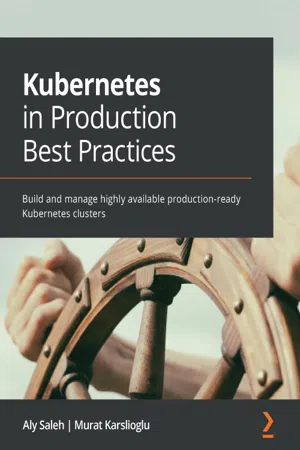
- 292 pages
- English
- ePUB (mobile friendly)
- Available on iOS & Android
Kubernetes in Production Best Practices
About this book
Design, build, and operate scalable and reliable Kubernetes infrastructure for productionKey Features• Implement industry best practices to build and manage production-grade Kubernetes infrastructure• Learn how to architect scalable Kubernetes clusters, harden container security, and fine-tune resource management• Understand, manage, and operate complex business workloads confidentlyBook DescriptionAlthough out-of-the-box solutions can help you to get a cluster up and running quickly, running a Kubernetes cluster that is optimized for production workloads is a challenge, especially for users with basic or intermediate knowledge. With detailed coverage of cloud industry standards and best practices for achieving scalability, availability, operational excellence, and cost optimization, this Kubernetes book is a blueprint for managing applications and services in production.You'll discover the most common way to deploy and operate Kubernetes clusters, which is to use a public cloud-managed service from AWS, Azure, or Google Cloud Platform (GCP). This book explores Amazon Elastic Kubernetes Service (Amazon EKS), the AWS-managed version of Kubernetes, for working through practical exercises. As you get to grips with implementation details specific to AWS and EKS, you'll understand the design concepts, implementation best practices, and configuration applicable to other cloud-managed services. Throughout the book, you'll also discover standard and cloud-agnostic tools, such as Terraform and Ansible, for provisioning and configuring infrastructure.By the end of this book, you'll be able to leverage Kubernetes to operate and manage your production environments confidently.What you will learn• Explore different infrastructure architectures for Kubernetes deployment• Implement optimal open source and commercial storage management solutions• Apply best practices for provisioning and configuring Kubernetes clusters, including infrastructure as code (IaC) and configuration as code (CAC)• Configure the cluster networking plugin and core networking components to get the best out of them• Secure your Kubernetes environment using the latest tools and best practices• Deploy core observability stacks, such as monitoring and logging, to fine-tune your infrastructureWho this book is forThis book is for cloud infrastructure experts, DevOps engineers, site reliability engineers, and engineering managers looking to design and operate Kubernetes infrastructure for production. Basic knowledge of Kubernetes, Terraform, Ansible, Linux, and AWS is needed to get the most out of this book.
Frequently asked questions
- Essential is ideal for learners and professionals who enjoy exploring a wide range of subjects. Access the Essential Library with 800,000+ trusted titles and best-sellers across business, personal growth, and the humanities. Includes unlimited reading time and Standard Read Aloud voice.
- Complete: Perfect for advanced learners and researchers needing full, unrestricted access. Unlock 1.4M+ books across hundreds of subjects, including academic and specialized titles. The Complete Plan also includes advanced features like Premium Read Aloud and Research Assistant.
Please note we cannot support devices running on iOS 13 and Android 7 or earlier. Learn more about using the app.
Information
Chapter 1: Introduction to Kubernetes Infrastructure and Production-Readiness
- The basics of Kubernetes infrastructure
- Why Kubernetes is challenging in production
- Kubernetes production-readiness
- Kubernetes infrastructure best practices
- Cloud-native approach
The basics of Kubernetes infrastructure
Kubernetes components

Control plane components
- kube-apiserver: The API server is the manager of the cluster components and it is the interface responsible for handling and serving the management APIs and middling the communication between cluster components.
- etcd: This is a distributed, highly available key-value data store that acts as the backbone of the cluster and stores all of its data.
- kube-controller-manager: This manages the controller processes that control the cluster – for example, the node controller that controls the nodes, the replication controller that controls the deployments, and the endpoint controller that controls services endpoints exposed in the cluster.
- kube-scheduler: This component is responsible for scheduling the pods across the nodes. It decides which pod goes to which node according to the scheduling algorithm, available resources, and the placement configuration.
Node components
- kubelet: An agent service that runs on each node in the cluster, this periodically takes a set of pod specs (a manifest file in YAML format that describes a pod specification) and ensures that the pods described through these specs are running properly. Also, it is responsible for reporting to the master on the health of the node where it is running.
- kube-proxy: This is an agent service that runs on each node in the cluster to create, update, and delete network roles on the nodes, usually using Linux iptables. These network rules allow inter-pod and intra-pod communication inside and outside of the Kubernetes cluster.
- Container runtime: This is a software component that runs on each node in the cluster, and it is responsible for running the containers. Docker is the most famous container runtime; however, Kubernetes supports other runtimes, such as Container Runtime Interface (CRI-O) and containerd to run containers, and kubevirt and virtlet to run virtual machines.
Why Kubernetes is challenging in production
Kubernetes production-readiness

Table of contents
- Kubernetes in Production Best Practices
- Contributors
- Preface
- Chapter 1: Introduction to Kubernetes Infrastructure and Production-Readiness
- Chapter 2: Architecting Production-Grade Kubernetes Infrastructure
- Chapter 3: Provisioning Kubernetes Clusters Using AWS and Terraform
- Chapter 4: Managing Cluster Configuration with Ansible
- Chapter 5: Configuring and Enhancing Kubernetes Networking Services
- Chapter 6: Securing Kubernetes Effectively
- Chapter 7: Managing Storage and Stateful Applications
- Chapter 8: Deploying Seamless and Reliable Applications
- Chapter 9: Monitoring, Logging, and Observability
- Chapter 10: Operating and Maintaining Efficient Kubernetes Clusters
- Other Books You May Enjoy